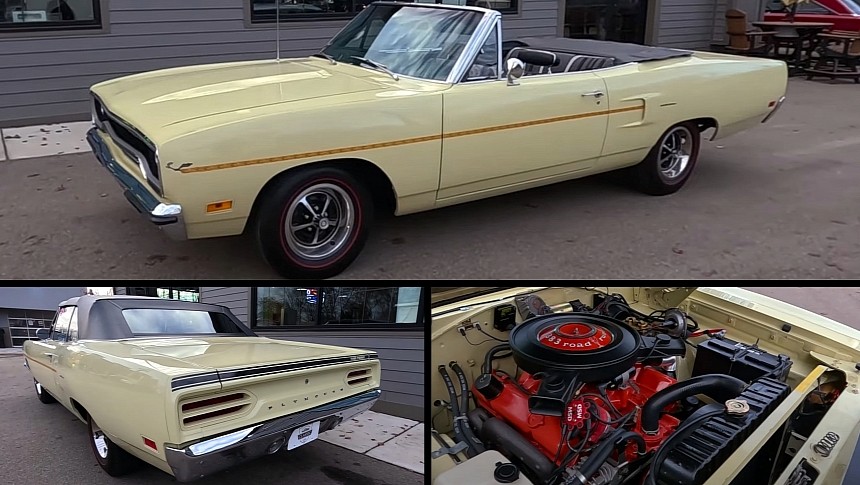After introducing the slightly fancied-up Satellite in 1964, Plymouth decided it needed a B-body vehicle combining performance and premium features. And the GTX was born in 1967. One year later, the company launched a trimmed-down, more affordable car called the Road Runner.
While it did not have the nice appointments of the GTX, the Road Runner was nothing to sneeze at in the performance department. Sure, the base model came with a 383-cubic-inch (6.3-liter) B-block, but the options list included the same range-topping mills as in the GTX. The Mopar was available with both the 440-cubic-inch (7.2-liter) RB and the 426-cubic-inch (7.0-liter) HEMI.
The big power with an affordable sticker recipe proved successful, and the Road Runner moved 44,303 units in its maiden and shortened 1968 model year, outselling the GTX by a ratio of 2.5 to one. The following year, the nameplate brought 81,105 buyers into showrooms, five times more than the GTX.
As muscle car sales began to drop into the new decade, the Road Runner still managed to move more than 36,000 examples in 1970. In 1971, the final year for high-performance Mopars, the Road Runner found 13,664 homes. 1971 also marked the end of the road for the HEMI, the rarest iteration of the Road Runner.
While Plymouth sold more than 175,000 examples from 1968 through 1971, only 2,262 cars were ordered with the 426-cubic-inch V8. The 1971 version is the scarcest with 55 units sold, followed by the 1970 variant with just 152 delivered. When it comes to body styles, though, the HEMI convertible is nearly impossible to find.
Not only was this layout only available in 1969 and 1970, but it was also selected by only 13 customers. Plymouth sold ten drop-tops in 1969 and just three units in 1970. The latter is the second most rarest HEMI classic ever produced.
But that's not to say that non-HEMI Road Runner cabriolets are common. Customers ordered only 1,890 units regardless of engine in 1969, while 1970 production came in at just 658 examples. And specific options turn many of these cars into rare gems. The 1970 Road Runner you see here is one of those cars.
Equipped with a 383-cubic-inch B-block, this Mopar may seem mundane at first glance. Well, it's not all that common at 621 units built, but we could call it familiar compared to the HEMI. However, this drop-top left the factory with a certain feature that makes it really scarce. I'm talking about the three-on-the-tree automatic gearbox.
You see, the Road Runner was available with three transmissions that year. The options list included the three-speed auto and four-speed manual in addition to the standard three-speed manual, which wasn't very popular. Of the 621 383-powered Road Runners sold, 179 had the four-speed manual, and 13 came with the three-speed version. This leaves 429 units specified with the three-speed auto.
Sure, it's not the rarest Mopar gearbox and not as desirable as the four-speed manual, but it's a diamond in the rough nevertheless, especially if you're a fan of classic muscle cars with front bench seats. And needless to say, the paint/upholstery/option combo likely makes it a one-of-one Plymouth. The fact that it's also a perfectly restored rig is the icing on the cake. Check it out in the video below.
The big power with an affordable sticker recipe proved successful, and the Road Runner moved 44,303 units in its maiden and shortened 1968 model year, outselling the GTX by a ratio of 2.5 to one. The following year, the nameplate brought 81,105 buyers into showrooms, five times more than the GTX.
As muscle car sales began to drop into the new decade, the Road Runner still managed to move more than 36,000 examples in 1970. In 1971, the final year for high-performance Mopars, the Road Runner found 13,664 homes. 1971 also marked the end of the road for the HEMI, the rarest iteration of the Road Runner.
While Plymouth sold more than 175,000 examples from 1968 through 1971, only 2,262 cars were ordered with the 426-cubic-inch V8. The 1971 version is the scarcest with 55 units sold, followed by the 1970 variant with just 152 delivered. When it comes to body styles, though, the HEMI convertible is nearly impossible to find.
Not only was this layout only available in 1969 and 1970, but it was also selected by only 13 customers. Plymouth sold ten drop-tops in 1969 and just three units in 1970. The latter is the second most rarest HEMI classic ever produced.
But that's not to say that non-HEMI Road Runner cabriolets are common. Customers ordered only 1,890 units regardless of engine in 1969, while 1970 production came in at just 658 examples. And specific options turn many of these cars into rare gems. The 1970 Road Runner you see here is one of those cars.
Equipped with a 383-cubic-inch B-block, this Mopar may seem mundane at first glance. Well, it's not all that common at 621 units built, but we could call it familiar compared to the HEMI. However, this drop-top left the factory with a certain feature that makes it really scarce. I'm talking about the three-on-the-tree automatic gearbox.
You see, the Road Runner was available with three transmissions that year. The options list included the three-speed auto and four-speed manual in addition to the standard three-speed manual, which wasn't very popular. Of the 621 383-powered Road Runners sold, 179 had the four-speed manual, and 13 came with the three-speed version. This leaves 429 units specified with the three-speed auto.
Sure, it's not the rarest Mopar gearbox and not as desirable as the four-speed manual, but it's a diamond in the rough nevertheless, especially if you're a fan of classic muscle cars with front bench seats. And needless to say, the paint/upholstery/option combo likely makes it a one-of-one Plymouth. The fact that it's also a perfectly restored rig is the icing on the cake. Check it out in the video below.












